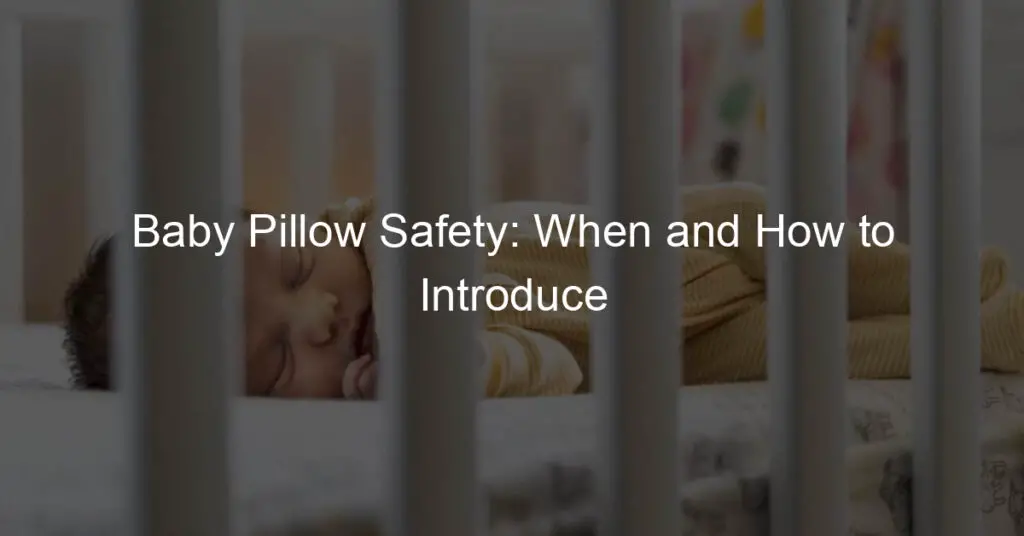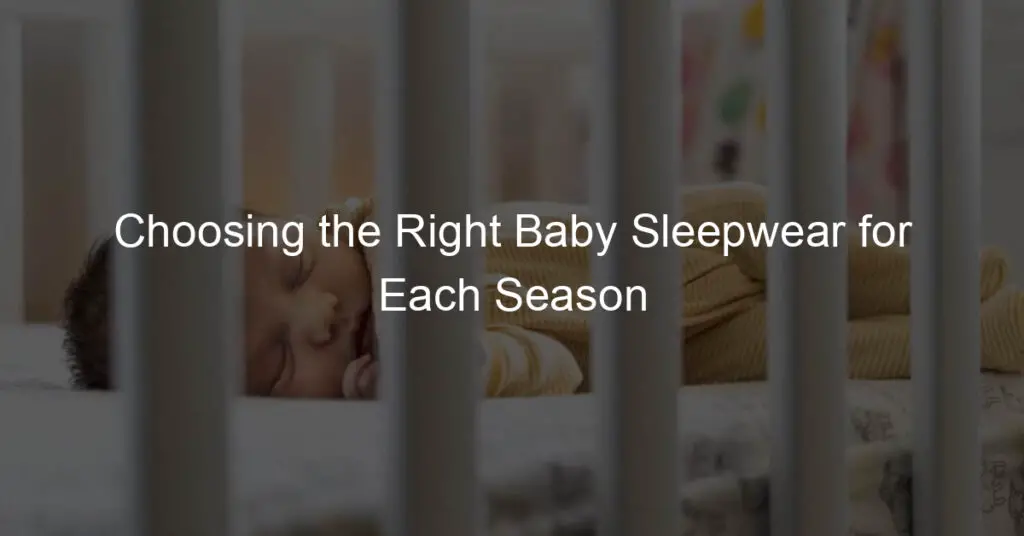This blog post provides a comprehensive guide on baby pillow safety, outlining when and how to properly introduce a pillow to your baby's sleep routine. It covers key aspects like the recommended age for introducing a pillow, types of safe pillows, potential risks, and tips for transition.
Understanding the Importance of Baby Pillow Safety
When it comes to the safety of our little ones, we cannot afford to overlook any potential risks. Baby pillow safety is a crucial aspect that every parent should be aware of. A pillow may seem harmless, but for a baby, it can pose serious dangers if not introduced at the right time and used correctly.
Babies have delicate bodies and developing neck muscles. Their heads are proportionally larger in comparison to the rest of their bodies. This makes it essential to provide adequate support and maintain proper alignment during sleep. The right pillow can help achieve this, but safety precautions must be taken into consideration.
Newborns and infants should not be introduced to pillows until they have reached a certain developmental milestone. This usually occurs around the age of 1 year. Before this age, babies do not have the necessary neck strength and control to move their heads if their breathing becomes compromised. It is crucial to prioritize their safety by avoiding the use of pillows too early on.
Using a pillow too soon can increase the risk of suffocation and Sudden Infant Death Syndrome (SIDS). Pillows can block a baby's airway or cause them to roll into an unsafe position during sleep. This is why it is crucial to understand the importance of baby pillow safety and follow the recommended guidelines.
By waiting until the appropriate age to introduce a pillow, you allow your baby's neck muscles to develop and strengthen. This ensures that they can adjust themselves if needed during sleep, reducing the risk of suffocation. Additionally, using a firm and breathable pillow specifically designed for babies can further enhance safety.
When is the Right Time to Introduce a Pillow?
Determining the right time to introduce a pillow to your baby is essential for their safety and comfort. Here are some key factors to consider:
- 1. Developmental Milestones:
The age at which you can introduce a pillow to your baby depends on their developmental milestones. Most experts recommend waiting until your baby is at least 1 year old. By this age, they have better head and neck control, reducing the risk of suffocation. However, it's important to remember that every baby develops at their own pace, so consult with your pediatrician for personalized advice. - 2. Ability to Roll Over:
Another important factor to consider is your baby's ability to roll over independently. Rolling over is a sign that their neck and upper body strength is developing, making it safer for them to use a pillow. If your baby can roll over both ways without assistance, it may be an indication that they are ready for a pillow. - 3. Sleep Position:
The sleep position your baby prefers can also influence the right time to introduce a pillow. If your baby sleeps on their back, it is generally safer to wait until they are older before introducing a pillow. However, if your baby prefers to sleep on their side or stomach (once they have the ability to roll over), a pillow can provide additional support and comfort.Remember, each baby is unique, and there is no one-size-fits-all approach. It's important to assess your baby's individual development and consult with your pediatrician before introducing a pillow. They can provide guidance based on your baby's specific needs and ensure that you make the right decision at the appropriate time.
What are the risks of introducing a pillow too early?
Introducing a pillow to your baby too early can pose several risks to their safety and well-being. Here are some important risks to consider:
- 1. Suffocation Hazard:
Infants have limited head and neck control, and a pillow can obstruct their airway if they end up face-down on it. This increases the risk of suffocation, especially if they are unable to move their head to a safe position. - 2. Overheating:
Babies are more susceptible to overheating than adults. Introducing a pillow too early can contribute to overheating, as it may restrict airflow around their head and increase their body temperature. This can lead to discomfort and increase the risk of sudden infant death syndrome (SIDS). - 3. Increased Risk of Allergies:
Pillows can harbor allergens like dust mites, which can trigger allergies in babies with sensitive respiratory systems. Introducing a pillow too early exposes them to these allergens, potentially leading to respiratory issues, such as sneezing, coughing, or difficulty breathing. - 4. Neck Strain:
Babies' neck muscles are still developing, and using a pillow too early may strain their delicate necks. A pillow that is too high or firm can cause their neck to bend at an unnatural angle, leading to discomfort or even musculoskeletal issues. - 5. Delayed Motor Development:
Using a pillow too early may hinder a baby's natural motor development. It is crucial for babies to have ample tummy time and freedom of movement during sleep to develop their muscles and coordination. A pillow can restrict their movement and hinder the development of important motor skills.
Choosing the Right Pillow for Your Baby
When it comes to choosing a pillow for your baby, there are several factors to consider to ensure their safety and comfort. Here are some key considerations:
- 1. Size and Firmness:
The size and firmness of the pillow are crucial. Opt for a small-sized pillow specifically designed for infants or toddlers. A pillow that is too large can pose a suffocation hazard. Additionally, choose a pillow that is firm enough to provide support but not too firm that it becomes uncomfortable for your baby. - 2. Breathability and Hypoallergenic Materials:
Look for a pillow made from breathable and hypoallergenic materials. This helps to prevent overheating and minimize the risk of allergies or skin irritations. Natural materials like organic cotton or bamboo are excellent choices as they are breathable and gentle on your baby's delicate skin. - 3.Washability:
Babies are prone to spills, drooling, and diaper leaks, so it's important to choose a pillow that is easy to clean. Look for a pillow with a removable and machine-washable cover. This will make it easier to keep the pillow clean and hygienic for your baby.Additionally, it's important to avoid pillows with additional features such as ribbons, buttons, or loose attachments. These can pose choking hazards for your baby. Keep it simple and opt for a pillow with minimal embellishments.
Remember, every baby is unique, and what works for one may not work for another. It's always a good idea to consult with your pediatrician or healthcare provider before introducing a pillow to your baby. They can provide guidance based on your baby's specific needs and ensure you make the best choice for their comfort and safety.
"Safety is not an intellectual exercise to keep us in work. It is a matter of life and death." – Richard J Hill
These powerful words by Richard J Hill highlight the importance of prioritizing safety when it comes to our little ones. When considering introducing a baby pillow, it is crucial to understand that it is not just a trivial decision but one that can have serious consequences. The safety of our babies should never be taken lightly.
As parents, it is our responsibility to ensure that every aspect of our baby's environment promotes their well-being. This includes their sleep environment and the pillows they use. By being mindful of safety guidelines and making informed choices, we can protect our little ones from potential hazards.
Richard J Hill's quote serves as a reminder that safety is not something we should overlook or treat as a mere formality. It is a matter of life and death, and we must approach it with the utmost seriousness and care. When it comes to introducing a baby pillow, we must prioritize the safety of our babies above all else.
By taking the time to educate ourselves on the proper timing and selection of a pillow, we can ensure that we are making a decision that aligns with the best interests of our babies. It is important to remember that safety is not just about following guidelines; it is about understanding the potential risks and making choices that mitigate them.
How to Transition Your Baby to a Pillow?
Transitioning your baby to a pillow requires careful consideration and a gradual approach. It is essential to ensure their safety and comfort during this process. Here are some steps to help you navigate this transition:
- 1. Timing is key:
Wait until your baby is at least 2 years old before introducing a pillow. By this age, they have developed sufficient neck strength and motor skills to adjust themselves during sleep. - 2. Start with a small pillow:
Choose a pillow specifically designed for toddlers, which is smaller and flatter than adult pillows. This will provide adequate support without posing a suffocation risk. - 3. Introduce the pillow gradually:
Begin by placing the pillow under the fitted sheet, at the head of the mattress. This allows your baby to become familiar with the presence of a pillow without direct contact. - 4. Observe your baby's response:
Pay attention to how your baby reacts to the pillow. If they seem uncomfortable or have difficulty sleeping, consider removing the pillow temporarily and trying again later. - 5. Provide reassurance:
Your baby may initially find the pillow unfamiliar and may resist using it. Offer comforting words, cuddles, or a favorite stuffed animal to help them feel secure during this transition. - 6. Monitor their sleep position:
Ensure that your baby's head is aligned with their body while using the pillow. Avoid pillows that are too high or firm, as they can strain the neck or cause discomfort. - 7. Check pillow condition:
Regularly inspect the pillow for any signs of wear and tear. Replace it if it becomes lumpy, uneven, or loses its shape to maintain optimal comfort and support. - 8. Be patient:
Every baby is unique, and the transition to a pillow may take time. Be patient and understanding as your little one adjusts to this new sleeping arrangement.
Can a Pillow Cause Flat Head Syndrome?
Flat Head Syndrome, also known as positional plagiocephaly, is a condition where an infant's head becomes flattened or misshapen. Many parents wonder if using a pillow can contribute to this condition. Let's explore this topic further:
- 1. Understanding Flat Head Syndrome:
Flat Head Syndrome typically occurs when a baby's head rests in the same position for extended periods, causing pressure on a particular area. This pressure can lead to flattening of the skull. It is important to note that Flat Head Syndrome can occur with or without the use of a pillow.2. Pillow Usage and Flat Head Syndrome:
Using a pillow that is too soft or too high can potentially increase the risk of Flat Head Syndrome. The excess padding may cause the baby's head to be positioned at an unnatural angle, putting pressure on certain areas. It is crucial to choose a pillow that is specifically designed for infants and provides appropriate support. - 3. Importance of Proper Head Positioning:
Proper head positioning is key in preventing Flat Head Syndrome. When using a pillow, it is essential to ensure that your baby's head is aligned with their body and not excessively tilted or elevated. This helps distribute the pressure evenly and reduces the risk of developing a flat spot on the head.It is worth mentioning that studies have shown that tummy time and regular repositioning of the baby's head can significantly reduce the risk of Flat Head Syndrome. Engaging in supervised tummy time while your baby is awake and alert allows them to strengthen their neck muscles and helps prevent constant pressure on one area of the head.
Does Your Baby Really Need a Pillow?
Many parents often wonder if their baby really needs a pillow. The answer to this question is not a straightforward one as it depends on various factors.
First and foremost, it is important to understand that newborns and young infants do not require a pillow. In fact, the American Academy of Pediatrics (AAP) recommends keeping the baby's sleep area free of pillows, blankets, and other soft bedding until they are at least one year old. This is because these items can pose a suffocation risk for infants who do not have the ability to move their heads or roll over independently.
As babies grow older and start transitioning to a crib or toddler bed, the question of introducing a pillow becomes more relevant. Some toddlers may prefer the added comfort and support that a pillow provides, while others may not show any preference or need for it.
When considering whether to introduce a pillow, it is essential to choose one that is specifically designed for infants and promotes proper spinal alignment. Look for a pillow that is firm, yet comfortable, and provides adequate neck support. Avoid pillows that are too soft or fluffy as they can increase the risk of suffocation or interfere with your baby's breathing.
Ultimately, the decision to introduce a pillow to your baby should be based on their individual needs and comfort. If you notice that your child is having trouble sleeping or seems uncomfortable without a pillow, it may be worth considering introducing one. However, always monitor your baby's sleep environment and ensure that the pillow is used safely and appropriately.
What to Do If Your Baby Resists a Pillow?
If your baby resists using a pillow, there are a few things you can try to make the transition smoother. First and foremost, it's important to respect your baby's preferences and comfort. If they are resisting the pillow, it could be because they simply don't need it yet or find it uncomfortable.
One option is to gradually introduce the pillow by placing it under the fitted sheet of the crib or toddler bed. This way, your baby can experience the slight elevation and support without directly lying on the pillow. This gradual approach allows them to adjust to the new sensation at their own pace.
Another strategy is to try different types of pillows. Your baby may have a preference for a specific shape, size, or firmness. Experiment with different options to find the one that your baby finds most comfortable. It's important to choose a pillow that is safe and appropriate for their age.
If your baby still resists using a pillow, it's essential to ensure that their sleep environment is otherwise comfortable and safe. Make sure the mattress is firm and supportive, and that the bedding is minimal and free from any suffocation hazards. Additionally, maintain a consistent bedtime routine that promotes relaxation and good sleep habits.
Remember that every baby is unique, and what works for one may not work for another. If your baby continues to resist a pillow despite your efforts, it's perfectly fine to wait a little longer before reintroducing it. As they grow and develop, their preferences and needs may change.
How to Keep Your Baby's Pillow Clean?
Keeping your baby's pillow clean is essential for their health and well-being. Here are some tips to help you maintain a clean pillow for your little one:
- 1. Use a pillowcase:
Invest in a soft and breathable pillowcase that fits snugly over the pillow. This will act as a barrier, protecting the pillow from dirt, spills, and stains. Opt for pillowcases made from natural materials like cotton, as they are hypoallergenic and gentle on your baby's delicate skin. - 2. Wash the pillowcase regularly:
To keep the pillow clean, it is important to wash the pillowcase regularly. Follow the manufacturer's instructions for washing and drying to ensure that the pillowcase stays in good condition. Aim to wash it at least once a week or more frequently if it becomes soiled. - 3. Spot clean as needed:
Accidents happen, and if your baby spills something on the pillow, it's important to address it promptly. Use a damp cloth and mild soap to spot clean the affected area. Avoid using harsh chemicals or bleach, as they may irritate your baby's skin or damage the pillow. - 4. Air out the pillow:
To keep the pillow fresh, allow it to air out regularly. Remove the pillow from the pillowcase and place it in a well-ventilated area, preferably in direct sunlight. Sunlight helps to naturally kill bacteria and freshen the pillow. - 5. Consider a pillow protector:
If you want an added layer of protection, consider using a pillow protector. These waterproof and hypoallergenic covers provide an extra barrier against spills, stains, and allergens. They are easy to remove and wash, keeping the pillow clean and hygienic.
Is it Time to Replace Your Baby's Pillow?
As your baby grows and develops, it's important to assess whether it's time to replace their pillow. Here are some factors to consider:
- 1. Age and size:
Babies grow rapidly, and their pillow needs may change accordingly. If your baby has outgrown their current pillow or it no longer provides adequate support, it may be time to replace it. Check for signs of discomfort or if their head is no longer properly supported. - 2. Wear and tear:
Regular use can cause wear and tear on the pillow. Inspect the pillow for any signs of damage, such as lumps, sagging, or flattened areas. If you notice any of these issues, it's a good indication that the pillow needs to be replaced. - 3. Allergies or sensitivities:
If your baby has allergies or sensitivities, it is important to regularly replace their pillow. Over time, pillows can accumulate dust mites, allergens, and other irritants. Consider using hypoallergenic pillows that are designed to resist allergens, or opt for pillows with removable, washable covers for easy cleaning. - 4. Hygiene concerns:
Even with regular cleaning, pillows can harbor bacteria, sweat, and oils from your baby's skin. If you notice a persistent odor or if the pillow is no longer fresh and clean after washing, it may be time to replace it. Maintaining good hygiene is essential for your baby's health and comfort. - 5. Comfort and support:
Ultimately, your baby's comfort and support should be the main determining factor in deciding whether to replace their pillow. If your baby is having trouble sleeping, frequently tossing and turning, or waking up with a sore or stiff neck, it may be a sign that their pillow is no longer providing the necessary comfort and support.
What are the Alternatives to Pillows?
While pillows are commonly used to provide comfort and support during sleep, they may not always be suitable for babies. There are alternatives that can offer a safe and comfortable sleep environment for your little one:
- 1. Rolled-up blanket or towel:
Instead of a traditional pillow, you can roll up a soft blanket or towel to create a gentle elevation under your baby's head. This can help prevent flat head syndrome while providing a bit of support. - 2. Sleep positioners:
Sleep positioners are designed to keep your baby in a specific sleeping position. They often come with cushions or wedges that provide support for your baby's head and body. However, it is essential to choose a sleep positioner that is safe and approved for use with infants. - 3. Mattress incline:
If your baby suffers from reflux or congestion, elevating the entire mattress slightly can help alleviate discomfort. This can be achieved by placing a rolled-up towel or wedge under the mattress, creating a gentle incline. - 4. Baby sleep sacks:
Sleep sacks are wearable blankets that eliminate the need for loose bedding, including pillows. They provide warmth and comfort while allowing your baby to move freely and safely during sleep.It's important to note that when using alternative sleep aids for your baby, you should always prioritize safety. Ensure that the chosen alternative is age-appropriate, promotes proper alignment, and reduces the risk of suffocation or entrapment.
"Are we not, in like manner, responsible for the safety of our little ones?" -Joseph Lancaster
As parents and caregivers, the responsibility of ensuring the safety of our little ones falls squarely on our shoulders. Joseph Lancaster, a renowned education reformer, aptly questioned our commitment to our children's safety. This question serves as a reminder that we must take proactive measures to protect our babies from potential hazards. Here are three important aspects to consider:
- 1. Creating a Safe Environment:
The physical environment in which our babies grow and explore plays a crucial role in their safety. We must carefully assess our homes, removing any potential dangers such as sharp objects, choking hazards, or toxic substances. Implementing safety measures like baby gates, outlet covers, and furniture anchors can prevent accidents and create a safe space for our little ones. - 2. Safe Sleep Practices:
The way we put our babies to sleep can greatly impact their safety. Following safe sleep practices, such as placing babies on their backs to sleep and ensuring a firm and clutter-free sleep surface, can reduce the risk of Sudden Infant Death Syndrome (SIDS). Additionally, keeping blankets, pillows, and stuffed animals out of the crib can further minimize the chance of suffocation. - 3. Supervision and Education:
Constant supervision is essential to keep our babies safe. As they grow and become more curious, it is crucial to closely monitor their activities to prevent accidents. Furthermore, educating ourselves about child safety guidelines and first aid procedures equips us with the knowledge and skills needed to respond effectively in case of emergencies.
Baby Pillow Safety:
| Recommended Age | Safe Pillow Types | Potential Risks | Transition Tips |
|---|---|---|---|
| 6 Months | Firm, hypoallergenic pillows | Suffocation, suffocation hazards | Gradually introduce the pillow over several nights |
| 12 Months | Thin, breathable pillows | Flat head syndrome, overheating | Introduce the pillow only when your baby can sit up unsupported |
| 18 Months | Organic, washable pillows | Overstimulation, allergies | Introduce the pillow only when your baby is comfortable sleeping on their back |
| 2 years | Memory foam, foam pillows | Sudden infant death syndrome, choking | Gradually introduce the pillow over several nights and monitor your baby's comfort |
Introducing a pillow to your baby's sleep routine is a significant step that requires careful consideration and planning. Always prioritize safety and consult with your pediatrician to ensure you're making the best decision for your child's well-being. Remember, every child is unique, and what works for one may not necessarily work for another.














